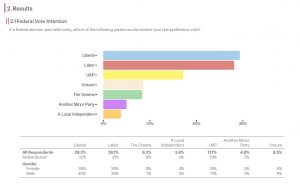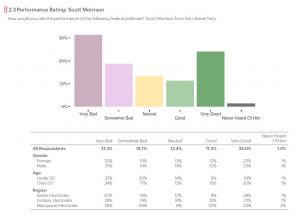Methodology
Throughout September, Redbridge conducted a number of quantitative surveys in Sydney and NSW. The most recent reported study (News limited 24th October) was conducted via touch-tone response automated phone survey conducted during the week commencing 13th September 2021. Surveys are conducted between 17:30 – 20:20 weekdays and 10:00 – 17:30 Saturdays at the local time of respondents so as to not over-sample nonworkers and stay-at-homes.
The study was conducted through the federal electorates of Banks, Lindsay and Macquarie (NSW) among a sample of n=1201 people aged 18 years and over from a population of over 464,000 (all ages). Telephone numbers were selected at random from those licensed from a commercial provider and included both landline and mobile phone numbers. In this survey 43.5% of respondents were reached via mobile phone.
Following the completion of the surveys, the data was cell-weighted by gender and age to reflect local population proportions. The weighting efficiency: 0.628 means the effective margin of sample error is +/-1.8%. (based on estimated enrolled voters)
Options were presented to respondents via a randomised sequence. Party names were read out to respondents. “United Australia Party”. Respondents who indicated that they were unsure, were then asked for a ‘lean’ preference.
The study identified a significant swing away from the federal government across the three federal electorates. The average two-party preferred vote across all three electorates was 53/47 – against the federal government.
The federal government has lost most of its 2019 support to the United Australia Party. That said, federal Labor has also lost some ground to minor parties. Overall, 50% of respondents rated the Prime Minister poorly.
These findings indicate a growing minor party presence in critical electorates across the country. However, this growth is not uniform as other Redbridge research has identified a much smaller level of support for minor parties in other parts of the country.
Like all seat-based polls – the usual warnings about using these findings as a predictor of election results. They instead should be used as a barometer of an electorate’s mood at the time of the survey.



Recent Comments